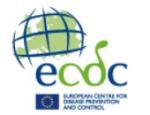Use of colistin-containing products within the European Union and European Economic Area (EU/EEA): development of resistance in animals and possible impact on human and animal health
Investigación publicada en International Journal of Antimicrobial Agents
1 de septiembre de 2015
Since its introduction in the 1950s, colistin has been used mainly as a topical treatment in human medicine owing to its toxicity when given systemically. Sixty years later, colistin is being used as a last-resort drug to treat infections caused by multidrug-resistant (MDR) Pseudomonas aeruginosa, Acinetobacter baumannii and Enterobacteriaceae (e.g., Escherichia coli, Klebsiella pneumoniae), for which mortality can be high. In veterinary medicine, colistin has been used for decades for the treatment and prevention of infectious diseases. Colistin has been administered frequently as a group treatment for animal gastrointestinal infections caused by Gram-negative bacteria within intensive husbandry systems. Given the ever-growing need to retain the efficacy of antimicrobials used to treat MDR infections in humans, the use of colistin in veterinary medicine is being re-evaluated. Despite extensive use in veterinary medicine, there is limited evidence for the development of resistance to colistin and no evidence has been found for the transmission of resistance in bacteria that have been spread from animals to humans. Since surveillance for colistin resistance in animals is limited and the potential for such transmission exists, there is a clear need to reinforce systematic monitoring of bacteria from food-producing animals for resistance to colistin (polymyxins). Furthermore, colistin should only be used for treatment of clinically affected animals and no longer for prophylaxis of diseases, in line with current principles of responsible use of antibiotics
Catry B., Cavaleri M., Baptiste K., Grave K., Grein K., Holm A., Jukes H., Liebana E., Navas AL., Mackay D., Magiorakos AP., Moreno MA., Moulin G., Madero CM., Pomba MC., Powell M., Pyorala S., Rantala M., Ruzauskas M., Sanders P., Teale C., Threlfall EJ., Torneke K., van Duijkeren E. y Edo JT.
| Scientific Institute of Public Health, Epidemiology Unit. European Programme for Intervention Epidemiology Training (EPIET). | |
| European Medicines Agency (EMEA). | |
| Danish Health and Medicines Agency. | |
| Veterinary Medicines Directorate (VMD). | |
| European Food Safety Authority (EFSA). | |
| Agencia Española de Medicamentos y Productos Sanitarios (AEMPS). Ministerio de Sanidad y Consumo. | |
 | European Centre for Disease Prevention and Control (ECDC). |
 | Departamento de Sanidad Animal. Facultad de Veterinaria. Universidad Complutense (UCM). |
 | Servicio de Zoonosis de Transmisión Alimentaria y Resistencia a Antimicrobianos (ZTA). Centro de Vigilancia Sanitaria Veterinaria (VISAVET). Universidad Complutense (UCM). |
| Agence Nationale de Sécurité Sanitaire de l´alimentation, de l´environnement et du travail (ANSES). | |
| Faculdade de Medicina Veterinária. Universidade Técnica de Lisboa (UTL). | |
| Medicines and Healthcare Products Regulatory Agency (MHRA). | |
| Department of Production Animal Medicine. Faculty of Veterinary Medicine. University of Helsinki. | |
| Lithuanian University of Health Sciences (LSMU). | |
| Animal Health and Veterinary Laboratories Agency (AHVLA). Department for Environment, Food and Rural Affairs (Defra). | |
| Consultant Clinical Scientist, Northwood. | |
| Läkemedelsverket Medical Products Agency. | |
| Laboratory for Zoonoses and Environmental Microbiology. Centre for Infectious Disease Control. National Institute for Public Health and the Environment (RIVM). | |
| Departamento de Farmacología, de Terapéutica y de Toxicología. Facultad de Veterinaria. Universitat Autònoma de Barcelona (UAB). | |
